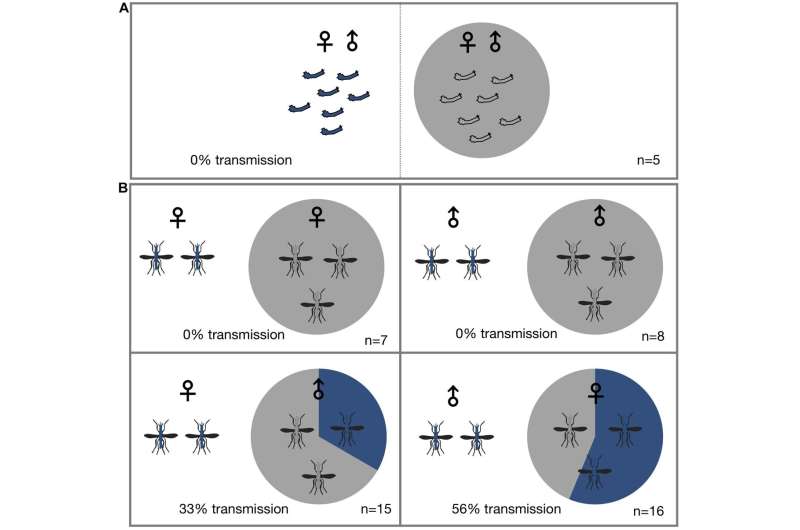Figure 1. Horizontal transmission of Microsporidia MB. Mosquitoes carrying Microsporidia MB are represented with blue shading in pie charts and n = number of independent experiments. (A) No transmission of Microsporidia MB was observed between An. arabiensis larvae reared in the same larval trough but separated by a screen mesh. (B) Horizontal transmission of Microsporidia MB was observed when adults were kept together in cages, and specifically when either infected males or females were housed with uninfected An. arabiensis of the opposite sex. Top row, no transmission was observed between infected and uninfected individuals of the same sex. Bottom left, transmission between Microsporidia MB infected An. arabiensis females and uninfected males was observed in 5 out of 15 cages (33%). Bottom right, out of a total of 16 experiments that had Microsporidia MB infected males and uninfected females and horizontal transmission was confirmed in 10 of these cages (56% transmission). Credit: DOI: 10.3389/fmicb.2021.647183
A microbe that is transmitted between male and female mosquitoes but can also block reproduction could be key to controlling malaria by targeting its release into mosquito populations, a study says.
The study published in Frontiers in Microbiology found that the microbe called Microsporidia MB can pass from one mosquito to another as they mate. It could also block the release of malaria parasites from infected mosquitoes.
"This finding is of major significance because it indicates that Microsporidia MB could be deployed as a tool to control malaria. However, for Microsporidia MB to be a viable tool, researchers will have to find a way to spread it into mosquito populations," says Jeremy Herren, a co-author of the study and a research scientist at the International Centre of Insect Physiology (icipe), in Kenya.
Herren tells SciDev.Net that while increasing use of important malaria control tools such as bed nets have led to a major decline in malaria over the last 20 years, progress in fighting malaria is stagnating.
One reason for this is that mosquitoes are becoming resistant to insecticides commonly used in treated bed nets, underscoring the need to develop new complementary disease-control tools.
"This study is, therefore, an important step towards the development of a completely new and potentially transformative strategy to control malaria." Herren adds. "The burden of malaria presents a major challenge for development goals in Africa. Over 90 percent of global malaria cases and deaths occur in Africa, which has enormous societal and economic consequences."
The study, which was conducted in 2019 through experiments on mosquitoes under laboratory conditions, involved the use of tools to determine whether or not individual mosquitoes have Microsporidia MB in them. Researchers also used a method called fluorescence microscopy to observe Microsporidia MB in the testes and ovaries of the mosquitoes.
According to Herren, the next step is to build on these findings to develop a viable strategy to spread Microsporidia MB through mosquito populations to control malaria transmission.
"We are exploring the feasibility ofreleasing male mosquitoes laden withMicrosporidia MBin areas of highmalaria transmission. These males would continue with their naturallife cycle, infecting wild female mosquitoes with the microbe, which wouldinturn infect their offspring with the malaria blocking trait," he says.
Brian Tarimo, a research scientist at the Ifakara Health Institute in Tanzania, says that the finding that the microbe is transmitted between mosquitoes of opposite sex during sexual reproduction makes it easy for this control intervention to spread throughout its population.
"This makes its deployment to the field much easier as it doesn't require human compliance or behavioral change. Furthermore, Microsporidia MB doesn't come along with a fitness cost in mosquitoes. This means that the chances of developing resistance against it is very slim to none," he tells SciDev.Net.
Adopting the microbe as a disease-control method, according to Tarimo, would be feasible but requires effective engagement with regulators, policymakers and community members.
He calls on health policymakers in malaria-endemic regions to invest in using the findings to create a novel tool to control malaria.
"Trends show that there is a plateau in the reduction of malaria cases while in some areas there is an increase. Therefore, novel control tools being developed … have to be seriously considered for addition into the control toolbox," he says.
More information: Godfrey Nattoh et al, Horizontal Transmission of the Symbiont Microsporidia MB in Anopheles arabiensis, Frontiers in Microbiology (2021). DOI: 10.3389/fmicb.2021.647183
Journal information: Frontiers in Microbiology
Provided by SciDev.Net























